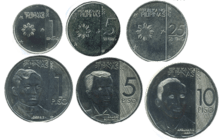Coins of the Philippine peso
Philippine peso coins are issued by the Bangko Sentral ng Pilipinas for circulation in the Philippines and are currently available in seven denominations. The Philippine peso has been in use since Spanish rule.
History
Both Spain and the United States struck coins for the Philippines while the latter was their colony. Spanish issues were 1 peso, 2 pesos and 4 pesos (all gold from 1861–1868 and again in 1880-1885). Silver fractional coinage ran from 1864–1868 and again from 1880–1885 and were in the denominations of ten centavo, twenty centavo and fifty centavo.
The United States also struck coins for use in the Philippines from 1903 to 1945. Denominations included the 1⁄2 centavo, one centavo, five centavo, 10 centavo, 20 centavo, 50 centavo, and one peso. The 1⁄2 and 1 centavo coins were struck in bronze, the 5 centavo struck in Copper (75%) - Nickel (25%), the 10, 20, 50 centavo and peso coins were struck in a silver composition. From 1903 to 1906, the silver coins had a silver content of 90%, while those struck after 1906 had a reduced silver content of 75% for 10 through 50 centavos and 80% for the peso. In both cases the silver was alloyed with copper.
The obverse of these coins remained largely unchanged during the years 1903 to 1945. The 1⁄2 centavo, one centavo, and five centavo coins depict a Filipino man kneeling against an anvil, with a hammer resting at his side. He is on the left side (foreground), while on the right side (background) there is a simmering volcano, Mt. Mayon, topped with smoke rings. This figure is an allegory for the hard work being done by the native peoples of the Philippines in building their own future.
The obverse of the 10, 20, 50 centavo, and peso coins are similar, but they show the figure of Liberty, a standing female figure (considered by many to be the daughter of the designer 'Blanca') in the act of striking the anvil with a hammer. This was done to show the work being done by Americans in building a better Philippines. Liberty appears on the silver coins, instead of the base metal coins.
The reverse of the coins comes in two varieties. The earliest coins were minted when the islands were a US Territory, and they bear the arms of the US Territories. This is a broad winged eagle, sitting atop a shield divided into two registers. The upper register has 13 stars, and the lower register has 13 vertical stripes. The date appears at the bottom, and "United States of America" appears at the top.
When the islands became a US Commonwealth, the arms of the Commonwealth were adopted. This seal is composed of a much smaller eagle with its wings pointed up, perched over a shield with peaked corners, above a scroll reading "Commonwealth of the Philippines". It is a much busier pattern, and widely considered less attractive.
Coins were minted at the Philadelphia, San Francisco, Denver, and (after it was opened in 1920) Manila mints. Most of the coins struck at the Manila mint occurred after 1925.
Proof sets were struck for collectors from 1903 to 1908. It is likely that a large majority of these sets remained unsold at the time they were issued. The recorded mintage for sets in 1905, 1906, and 1908 is a modest 500.
Defenders of Corregidor threw a large number of silver coins into the ocean, rather than allow the Japanese to accumulate this wealth. A great deal of the booty was later recovered, but many of those were badly corroded.
Among the rarest coins in the U.S. Philippines series from the collectors' standpoint are the 1906-S One Peso, the 1916-S Five Centavos, the 1918-S Five Centavo Mule, the 1903-S Twenty Centavos (especially in Mint State) and the 1915-S One Centavo.
Three Commemorative coins were minted to celebrate the Commonwealth in 1936. They show President Franklin D. Roosevelt, Commonwealth President Manuel L. Quezon and U.S. High Commissioner Frank Murphy, who also has served as the last Governor General of the Islands. The 50 Centavo commemorative has a reported mintage of 20,000 pieces, was struck in 75% silver, and weighs 10 grams (the same specifications as other 50 centavos). The two varieties of One Peso commemorative had reported mintages of 10,000 pieces. They weigh 20 grams, and are 90% silver.
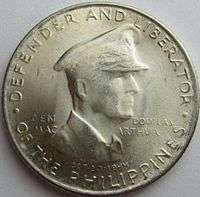
After the granting of independence to the Philippines in 1946, no coins were minted for the Philippine Republic until 1958, other than a small silver commemorative issue in 1947 to honor General Douglas MacArthur. Totals of 200,000 50 centavos and 100,000 one peso coins were minted with the general's image on the obverse and the national coat-of-arms on the reverse. Struck at the San Francisco Mint, they carry the "S" mintmark below the date.
In 1958, the 20 centavos was replaced with a 25 centavos and all coins were resized to be the same diameter as their US equivalents, albeit in more base metals, other than the centavo. The same seated man with anvil and volcano or standing liberty with anvil and volcano designs were retained for the obverses while the seal of the Central Bank of the Philippines dominated the reverse. These coins were minted by the Philadelphia Mint from 1958 through 1963, and then by the Royal Mint in England and the Vereinigte Deutsche Metallweke in West Germany in 1965 (dated 1964) and 1966. In view of all subsequent issues using the Tagalog language, this coinage is often referred to as the "English Series" since it uses the English language.
The next series was introduced in 1967, introducing images of various Philippine national heroes, and the use of the Tagalog (or "Pilipino") language, hence being called the "Pilipino Series." The sizes of the coins were reduced. These coins were struck by the various US mints, except for some 50 centavos pieces dated 1972 which were minted in Singapore, and a couple commemorative issues struck by the Sherritt Mint in Canada. In 1972 the one peso denomination was reintroduced.
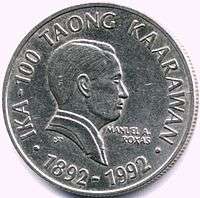
In commemoration of Fedinand Marcos' declaration of Martial Law (which he titled "Ang Bagong Lipunan," the new society), a new series of coinage was issued in 1975, referred to as the Ang Bagong Lipunan Series. The 50 sentimo was done away with as a denomination and a new 5 peso issue took its place. A variety of mints provided these coins, including the Royal Mint in England and the Vereinigte Deutsche Metallweke in West Germany, Philadelphia and San Francisco mints in the US, the Franklin Mint (a private mint also in the US), the Sherritt Mint in Canada, and finally the Philippine's own mint, once it was opened and able to produce coinage. From this point on, the Philippine Mint (Bangko Sentral Pilipinas, "BSP") produced nearly all Philippine coinage.
After eight years, the Ang Bagong Lipunan series gave way to a new series titled the Flora and Fauna Series, in which the coins, in addition to featuring various Philippine national heroes as before, also began featuring various plant and animal life forms native to the Philippines. The 50 sentimo and 2 piso denominations were reintroduced, which latter had not been struck as a coin since the Spanish had struck it in gold. The 5 Piso denomination was stopped, but resumed (in a new smaller size) concurrent to the final four years of the Flora and Fauna Series which featured reduced sizes for all denominations. The Flora and Fauna Series was struck from 1983 through 1994.
In 1995, the New BSP Series was introduced, which is still circulating today. Only this current series of coins are legal tender as of January 2, 1998, when the Bangko Sentral ng Pilipinas issued BSP Circular No. 81 which called for the demonetization of all previous existing Central Bank coins minted before 1995.
Recently, fake 10- and 5-piso coins dating 2001 and 2002 have entered circulation. Because of this, the Bangko Sentral ng Pilipinas issued a warning and several security measures on importing and falsifying Philippine coins. And it is because the BSP has announced that there is an artificial shortage of coins last June 2006. The BSP has asked the public to use all small coins or to have them exchanged for banknotes in local banks or other financial institution.
Denominations worth 25 sentimo (~US$0.005) and below are still issued but have been increasingly regarded as a nuisance. Proposals to retire and demonetize all coins less than one peso in value have been rejected by the government and the BSP.[1]
On November 29, 2017, the Bangko Sentral ng Pilipinas announced the release of the first coin in the New Generation Currency Coin series for circulation starting December 2017. As a tribute to the 154th birth anniversary of Andres Bonifacio, the first coin to be released was the new silver-colored 5-peso coin featuring Bonifacio on the obverse, replacing Emilio Aguinaldo. The reverse features the Tayabak plant and the new BSP logo.[2] The rest of the NGC coin series were presented on March 26, 2018.[3]
The 20 piso banknote will be changed into a coin to be released in the last quarter of 2019 or first quarter of 2020 to solve the over-usage of the banknote leading for only one year to exchange it a new one, as the University of the Philippines said. The Bangko Sentral ng Pilipinas states that the 20 piso coin lasts for 10 to 15 years longer than the banknote which has the same value. They were released on December 17, 2019.[4]
Formerly circulating coins
The Philippines under U.S. Sovereignty
| Image | Face Value | Technical parameters | Description | Total Mintage[5] | Years of Issue[6] | ||||||
|---|---|---|---|---|---|---|---|---|---|---|---|
| Obverse | Reverse | Diameter | Thickness | Mass | Composition | Edge | Obverse | Reverse | |||
 |
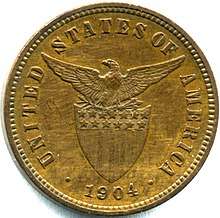 |
1⁄2 centavo | 17.5 mm | 2.59 g | Bronze | Plain | Figure of a man seated beside an anvil holding a hammer and Mt. Mayon, year of minting | des. | 12,084,000 5,654,000 471 500 500 |
1903 1904 1905 1906 1908 | |
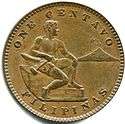 |
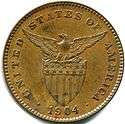 |
1 centavo | 24 mm | 5.18 g | Bronze | Plain | Figure of a man seated beside an anvil holding a hammer and Mt. Mayon, year of minting | des. | 10,790,000 17,040,400 10,000,000 500 500 2,187,000 1,737,612 2,700,000 4,803,000 3,001,000 5,000,000 5,000,500 2,500,000 4,330,000 7,070,000 11,660,000 4,540,000 2,500,000 3,552,259 7,282,673 3,519,100 9,325,000 9,000,000 9,279,000 9,150,000 5,657,161 5,577,000 5,659,355 4,000,000 8,392,692 3,179,000 17,455,463 |
1903 1904 1905 1906 1908 1908 S 1909 S 1910 S 1911 S 1912 S 1913 S 1914 S 1915 S 1916 S 1917 S 1918 S 1919 S 1920 S 1920 1921 1922 1925 M 1926 M 1927 M 1928 M 1929 M 1930 M 1931 M 1932 M 1933 M 1934 M 1936 M | |
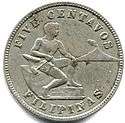 |
 |
5 centavos | 20.5 mm (1903–1928) 19 mm (1930–1935) | 5.00 g (1903-1928)
4.87 g (1930-1935) |
Copper-Nickel | Plain | Figure of a man seated beside an anvil holding a hammer and Mt. Mayon, year of minting | des. | yyyy | 1903 1904 1905 1906 1908 1916 S 1917 S 1918 S 1919 S 1920 1921 1925 M 1926 M 1927 M 1928 M 1929 M 1930 M 1931 M 1932 M 1933 M 1934 M 1935 M | |
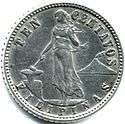 |
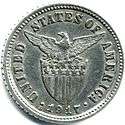 |
10 centavos | 17.5 mm (1903–1906) 16.5 mm (1907–1935) | 2.69 g (1903–1906) 2 g (1907–1935) | 90% Silver (1903–1906) 75% Silver (1907–1935) | Reeded | Lady Liberty striking an anvil with a hammer and Mt. Mayon, year of minting | des. | yyyy | 1903 1903 S 1904 1904 S 1905 1906 1907 1907 S 1908 1908 S 1909 S 1911 S 1912 S 1913 S 1914 S 1915 S 1916 S 1917 S 1918 S 1919 S 1920 1921 1929 M 1935 M | |
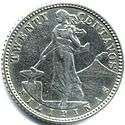 |
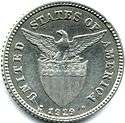 |
20 centavos | 23 mm (1903–1906) 20 mm (1907–1929) | 5.384 g (1903–1906) 4 g (1907–1929) |
yyyy | 1903 1903 S 1904 1904 S 1905 1905 S 1906 1907 1907 S 1908 1908 S 1909 S 1910 S 1911 S 1912 S 1913 S 1914 S 1915 S 1916 S 1917 S 1918 S 1919 S 1920 1921 1928 M 1929 M | |||||
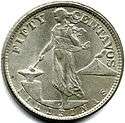 |
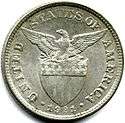 |
50 centavos | 30 mm (1903–1906) 27 mm (1907–1921) | 13.478 g (1903–1906) 10 g (1907–1935) |
yyyy | 1903 1903 S 1903 S 1904 1904 S 1905 1905 S 1906 1907 1907 S 1908 1908 S 1909 S 1917 S 1918 S 1919 S 1920 1921 | |||||
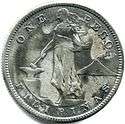 |
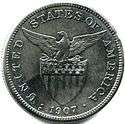 |
1 Peso | 38 mm (1903–1906) 35 mm (1907–1912) | 26.956 g (1903–1906) 20 g (1907–1912) |
yyyy | 1903 1903 S 1904 1904 S 1905 1905 S 1906 1906 S 1907 S 1908 1908 S 1909 S 1910 S 1911 S 1912 S | |||||
Commonwealth Issues
In 1935, when the Commonwealth was established by the Congress of the United States, they issued a three-piece commemorative set (that sold very poorly) to commemorate the occasion. In 1937, the Commonwealth Arms were adapted to all circulating coinage. (Mint marks are M for Manila, D for Denver, S for San Francisco, and no mint mark for Philadelphia)
| Commonwealth Issues | |||||||||||
|---|---|---|---|---|---|---|---|---|---|---|---|
| Image | Face Value | Technical parameters | Description | Total Mintage[5] | Years of Issue[6] | ||||||
| Obverse | Reverse | Diameter | Thickness | Mass | Composition | Edge | Obverse | Reverse | |||
 |
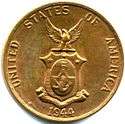 |
1 centavo | 24 mm | 5.18g | Bronze | Plain | The figure of an adolescent native, seated at an anvil and holding a hammer in his right hand. In the distance is seen the smoking volcano of Mt. Mayon, located on the main island of Luzon. The statement of value appears above him (One, and/or Five Centavos) in English, while the name of the archipelago is written below in Spanish as FILIPINAS.[7][lower-alpha 1] |
The coat of arms of the Commonwealth of the Philippines. Around this appeared the legend UNITED STATES OF AMERICA, the mint mark, and the date of coinage.[7][lower-alpha 2] | 15,790,492 10,000,000 6,500,000 4,000,000 5,000,000 58,000,000 |
1937 M 1938 M 1939 M 1940 M 1941 M 1944 S | |
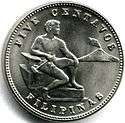 |
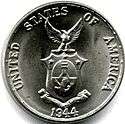 |
5 centavos | 19 mm | 1.9 mm | 4.9 g | 75% Copper 25% Nickel Zinc | Plain | 2,493,872 4,000,000 2,750,000 21,198,000 14,040,000 |
1937 M 1938 M 1941 M 1944 1944 S 1945 S | ||
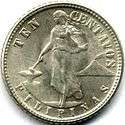 |
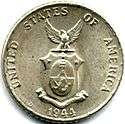 |
10 centavos | 16.5 mm | 2 g | 75% Silver 25% Copper | Reeded | The standing figure of an adolescent female was utilized. She is clad in a long, flowing gown and holds in her right hand a hammer, resting atop an anvil, as seen on the minor coins. Behind her is again Mt. Mayon, an almost perfectly conical volcanic mountain southeast of the capital city of Manila. The statement of value appears above her (Ten, Twenty, and/or Fifty Centavos) in English, while the name of the archipelago is written below in Spanish as FILIPINAS.[7][lower-alpha 3] | 3,500,000 3,750,000 2,500,000 31,592,000 137,208,000 |
1937 M 1938 M 1941 M 1944 D 1945 D | ||
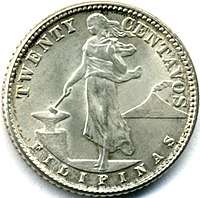 |
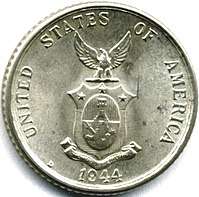 |
20 centavos | 20 mm | 1.9 mm | 4 g | 2,665,000 3,000,000 1,500,000 28,596,000 82,804,000 |
1937 M 1938 M 1941 M 1944 D 1945 D | ||||
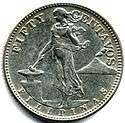 |
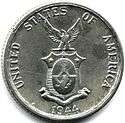 |
50 centavos | 27.5 mm | 10 g | 19,187,000 18,120,000 |
1944 S 1945 S | |||||
Commonwealth Commemorative Issues
| Commonwealth Commemorative Issues | |||||||||||
|---|---|---|---|---|---|---|---|---|---|---|---|
| Image | Face Value | Technical parameters | Description | Total Mintage | Years of Issue | ||||||
| Obverse | Reverse | Diameter | Thickness | Mass | Composition | Edge | Obverse | Reverse | |||
| 50 centavos | 27.5 mm | # mm | 10.000 | 0.7500 Silver | Reeded | description | Busts of Murphy and Quezon | 20,000 | 1936 M | ||
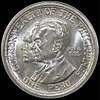 |
 |
1 Peso | 35 mm | # mm | 20.000g | 0.9000 Silver | Reeded | description | Busts of Murphy and Quezon | 10,000 | 1936 M |
| 1 Peso | 35 mm | # mm | 20.000g | 0.9000 Silver | Reeded | description | Busts of Roosevelt and Quezon | 10,000 | 1936 M | ||
English series
In 1958, a new, entirely base metal coinage was introduced, consisting of bronze 1 centavo, brass 5 centavos and nickel-brass 10, 25 and 50 centavos. This series was demonetized after August 31, 1979, except for the 10-centavo that was demonetized only after January 2, 1998.[8]
| English Series | ||||||||||||
|---|---|---|---|---|---|---|---|---|---|---|---|---|
| Image | Face Value | Technical parameters | Description | Total Mintage | Date of | |||||||
| Obverse | Reverse | Diameter | Thickness | Mass | Composition | Edge | Obverse | Reverse | issue | demonetization | ||
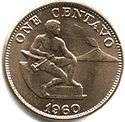 |
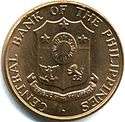 |
1 centavo | 18.5 mm | 2.5 g | Bronze | Plain | Figure of a man seated beside an anvil holding a hammer and Mt. Mayon, year of minting | Bank title and coat of arms | July 1, 1958 | Aug 31, 1979 | ||
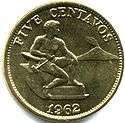 |
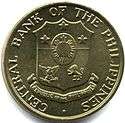 |
5 centavos | 20.0 mm | 3.7 g | Brass | Plain | Figure of a man seated beside an anvil holding a hammer and Mt. Mayon, year of minting | Bank title and coat of arms | July 1, 1958 | Aug 31, 1979 | ||
 |
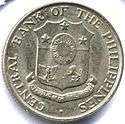 |
10 centavos | 17.5 mm | 2.05 g | Nickel-brass | Reeded | Lady Liberty striking an anvil with a hammer and Mt. Mayon, year of minting | Bank title and coat of arms | July 1, 1958 | Jan 2, 1998 | ||
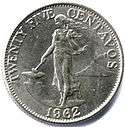 |
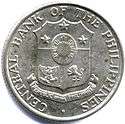 |
25 centavos | 23.5 mm | 4.8 g | Aug 31, 1979 | |||||||
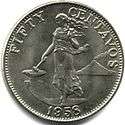 |
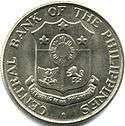 |
50 centavos | 30.0 mm | 10.3 g | ||||||||
Pilipino series
In 1967, the coinage was altered to reflect the use of Filipino names for the currency units. 1-piso coins were reintroduced in 1972. The series was demonetized on Jan. 2, 1998.[9]
| Pilipino Series | ||||||||||
|---|---|---|---|---|---|---|---|---|---|---|
| Image | Value | Diameter | Mass | Composition | Edge | Obverse | Reverse | Year of | ||
| Obverse | Reverse | first minting | demonetization | |||||||
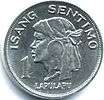 |
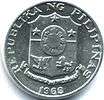 |
1 sentimo | 15.21 mm | 0.50 g | Aluminum | Plain | Lapu-Lapu | State title, coat of arms, year of minting | May 5, 1967 | Jan 2, 1998 |
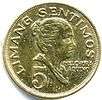 |
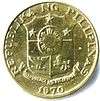 |
5 sentimos | 18.0 mm | 1.7 g | Brass | Plain | Melchora Aquino | State title, coat of arms, year of minting | May 5, 1967 | Jan 2, 1998 |
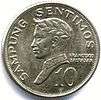 |
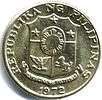 |
10 sentimos | 17.5 mm | 1.98 g | Nickel-brass | Reeded | Francisco Baltazar | State title, coat of arms, year of minting | May 5, 1967 | Jan 2, 1998 |
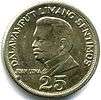 |
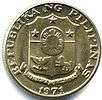 |
25 sentimos | 21.0 mm | 4 g | Juan Luna | |||||
 |
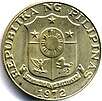 |
50 sentimos | 27.0 mm | 7 g | Marcelo H. del Pilar | |||||
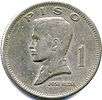 |
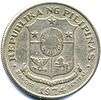 |
₱1 | 33.0 mm | 15 g | José Rizal | State title, coat of arms, year of minting between the words "BANGKO" and "SENTRAL" | February 6, 1972 | |||
Ang Bagong Lipunan series
In 1975, the Ang Bagong Lipunan (The New Society) series, was introduced with ₱5 coins included for this series. Aluminium replaced bronze and cupro-nickel replaced nickel-brass that year. The series was demonetized on Jan. 2, 1998.[10]
| Ang Bagong Lipunan Series | ||||||||||
|---|---|---|---|---|---|---|---|---|---|---|
| Image | Value | Diameter | Mass | Composition | Edge | Obverse | Reverse | Year of | ||
| Obverse | Reverse | first minting | demonetization | |||||||
 |
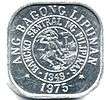 |
1 sentimo | 16.5 mm (length of side of rounded square shaped edge) | 1.22 g | Aluminum | Plain | State title, Lapu-Lapu, value | "ANG BAGONG LIPUNAN," BSP logo, year of minting | March 31, 1975 | Jan 2, 1998 |
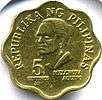 |
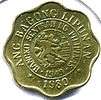 |
5 sentimos | 19 mm (8-pointed rounded scallop edge) | 2.40g | Brass | Plain | State title, Melchora Aquino, value | "ANG BAGONG LIPUNAN," BSP logo, year of minting | March 31, 1975 | Jan 2, 1998 |
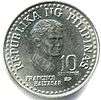 |
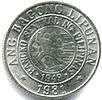 |
10 sentimos | 17.5 mm | 2g | Cupro-Nickel | Reeded | State title, Francisco Baltazar, value | "ANG BAGONG LIPUNAN," BSP logo, year of minting | March 31, 1975 | Jan 2, 1998 |
 |
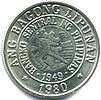 |
25 sentimos | 21.0 mm | 4g | State title, Juan Luna, value | |||||
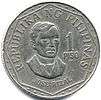 |
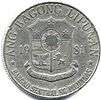 |
₱1 | 29 mm | 9.5g | State title, José Rizal, value | "ANG BAGONG LIPUNAN," coat of arms with the scroll text altered to "ISANG BANSA, ISANG DIWA" ("One Nation, One Spirit") with two digits of the year minted on both sides, bank title | ||||
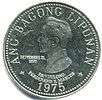 |
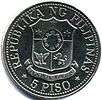 |
₱5 | 35 mm | 22g | "ANG BAGONG LIPUNAN," "Setyembre 21, 1972" ("September 21, 1972"), Ferdinand Marcos, year of minting | State title, coat of arms with the scroll text altered to "ISANG BANSA, ISANG DIWA" ("One Nation, One Spirit") | ||||
Flora and Fauna series
The Flora and Fauna series was introduced in 1983 which included ₱2 coins. This series used the Optima typeface. ₱5 coins were reintroduced in 1991, and reduced-size 25-sentimo, 50-sentimo, ₱1 and ₱2 coins were distributed starting Dec 1992. Production of 50-sentimo and ₱2 coins ceased in 1995. The series was demonetized on Jan. 2, 1998.[11]
The Flora and Fauna series had an error for some coins, in 1983. The text for 10 centavos for scientific name of the Philippine goby was "Pandaka pygmea" instead of "Pandaka pygmaea" and the 50 centavo coin for the Philippine eagle was "Pithecobhaga jefferyi" instead of "Pithecophaga jefferyi".
| Flora and Fauna Series | |||||||||||
|---|---|---|---|---|---|---|---|---|---|---|---|
| Image | Value | Diameter | Thickness | Mass | Composition | Edge | Obverse | Reverse | Year of | ||
| Obverse | Reverse | Introduction | Demonetization | ||||||||
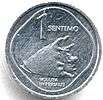 |
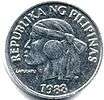 |
1 sentimo | 15.5 mm | 1.67mm | 0.70 g | Aluminum and Magnesium 99.2% Al 0.8% Mg |
Plain | Voluta imperialis, Value | State title, Lapu-Lapu, year of minting | September 30, 1983 | Jan 2, 1998 |
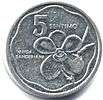 |
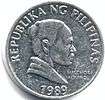 |
5 sentimo | 17.0 mm | 2.04mm | 1.10 g | Vanda sanderiana (Waling-waling), Value | State title, Melchora Aquino, year of minting | ||||
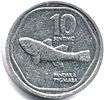 |
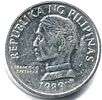 |
10 sentimo | 19.0 mm | 2.27mm | 1.50 g | Pandaka pygmaea (Philippine Goby), Value | State title, Francisco Baltazar, value, year of minting | ||||
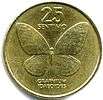 |
 |
25 sentimo | 21.0 mm | 1.67mm | 3.85 g | Brass (65% copper; 35% zinc) | Reeded | Graphium idaeoides, Value | State title, Juan Luna, year of minting | September 30, 1983 | Jan 2, 1998 |
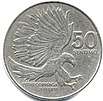 |
 |
50 sentimo | 25.0 mm | 1.67mm | 6.05 g | Copper-nickel 75% Cu 25% Ni |
Plain | Pithecophaga jefferyi (Philippine Eagle), Value | State title, Marcelo H. del Pilar, year of minting | September 30, 1983 | Jan 2, 1998 |
 |
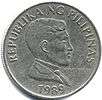 |
₱1 | 29.0 mm | 2.06mm | 9.5 g | Reeded | Anoa mindorensis (Tamaraw), Value | State title, José Rizal, year of minting | |||
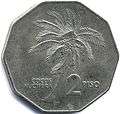 |
 |
₱2 | 31 mm (across corners, decagon) 29.8 mm (across flats, decagon) |
2.18mm | 12 g | Plain | Cocos nucifera (Coconut Tree), Value | State title, Andrés Bonifacio, year of minting | |||
| Improved Flora and Fauna Series (1991–1994) | |||||||||||
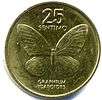 |
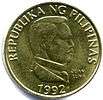 |
25 sentimo | 16.0 mm | 1.67mm | 2.2 g | Brass | Plain | Graphium idaeoides, Value | State title, Juan Luna, year of minting | Dec 1992 | Jan 2, 1998 |
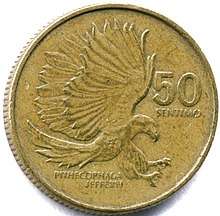 |
 |
50 sentimo | 17.5 mm | 1.8mm | 3 g | Reeded | Pithecophaga jefferyi (Philippine Eagle), Value | State title, Marcelo H. del Pilar, year of minting | |||
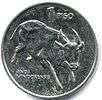 |
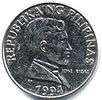 |
₱1 | 21.6 mm | 1.67mm | 4 g | Stainless steel | Plain | Anoa mindorensis (Tamaraw), Value | State title, José Rizal, year of minting | Dec 1992 | Jan 2, 1998 |
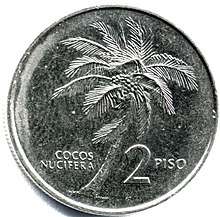 |
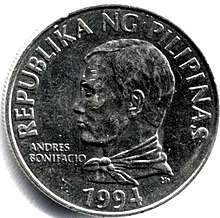 |
₱2 | 24.0 mm | 2 mm | 5 g | Reeded | Cocos nucifera (Coconut Tree), Value | State title, Andrés Bonifacio, year of minting | |||
 |
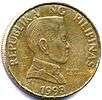 |
₱5 | 25.5 mm | 2.5mm | 9.5 g | Nickel-brass | Reeded | Pterocarpus indicus (Narra), Value | State title, Emilio Aguinaldo, year of minting | April 1, 1991 | Jan 2, 1998 |
Circulating coins
BSP Coin series
In December 1995, a new set of coins and notes was issued which carried the logo of the new BSP: 5- and 1-piso and 25-, 10-, 5- and 1-sentimo, with the aim of carrying out the demonetization of all previous series by Jan 2, 1998. On July 10, 2001, BSP issued the 10-piso coin for general circulation to commemorate its 8th anniversary. It has the profiles of Andres Bonifacio and Apolinario Mabini in a con-joint or in tandem manner on the obverse side. The reverse side bears the seal of the Bangko Sentral ng Pilipinas which is consistent with the common reverse design of the other six denominations. This has been an additional denomination to the current coin circulation and a replacement for the 10-piso NDS banknote. The series used again the Optima typeface.
The 1995, 1997 and 1998 5 peso coins had no mint marks, but coins issued from 1999 onward had mint marks. The 1997 and 1998 coins (with no mint mark) were minted by the Royal Canadian Mint. However, not all 1997 and 1998 coins were minted by the Royal Canadian Mint, quite a few were minted by the BSP (with mint mark).
| Image | Face Value | Technical parameters | Description | Years of Issue | |||||||
|---|---|---|---|---|---|---|---|---|---|---|---|
| Obverse | Reverse | Diameter | Mass | Composition | Edge Thickness | Edge | Obverse | Reverse | Introduced | Withdrawn | |
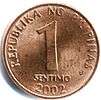 |
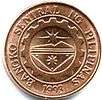 |
1 sentimo | 15.5 mm | 2.0 g | Copper-plated steel | 1.50 mm | Plain | "Republika ng Pilipinas", value, year of minting | 1993 Logo of the Bangko Sentral ng Pilipinas | Dec 1995 | |
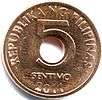 |
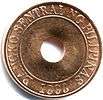 |
5 sentimo | 15.5 mm | 1.9 g | 1.50 mm | Plain (with 4 mm central hole) |
"Republika ng Pilipinas", value, year of minting | Words "Bangko Sentral ng Pilipinas" along the border | |||
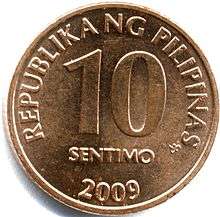 |
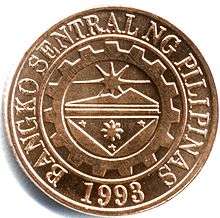 |
10 sentimo | 17.0 mm | 2.5 g | 1.55 mm | Reeded | "Republika ng Pilipinas", value, year of minting | 1993 Logo of the Bangko Sentral ng Pilipinas | |||
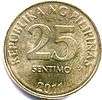 |
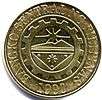 |
25 sentimo | 20.0 mm | 3.8 g | Brass | 1.65 mm | Plain | "Republika ng Pilipinas", value, year of minting | 1993 Logo of the Bangko Sentral ng Pilipinas | Dec 1995 | |
| 3.6 g | Brass-plated steel | 1.65 mm | March 22, 2004 | ||||||||
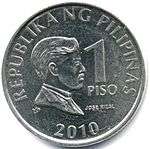 |
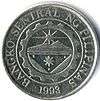 |
₱1 | 24.0 mm | 6.1 g | Copper-nickel | 1.85 mm | Reeded | "Republika ng Pilipinas", Profile of José Rizal, value, year of minting | 1993 Logo of the Bangko Sentral ng Pilipinas | Dec 1995 | |
| 5.35 g | Nickel-plated steel | 1.85 mm | April 21, 2003 | ||||||||
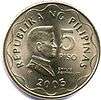 |
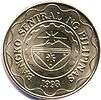 |
₱5 | 27.0 mm | 7.7 g | Nickel-brass (70% copper 5.5% nickel 24.5% zinc) |
1.90 mm | Plain |
12-pointed scallop border design, "Republika ng Pilipinas", Profile of Emilio Aguinaldo, value, year of minting | 12-pointed scallop border design, 1993 Logo of the Bangko Sentral ng Pilipinas | Dec 1995 | |
 |
 |
₱10 | 26.5 mm | 8.7 g | Ring: Copper-nickel | 2.10 mm | Segmented (Plain and Reeded edges) | Ring: "Republika ng Pilipinas", year of minting | 1993 Logo of the Bangko Sentral ng Pilipinas | July 10, 2001 | |
| Center: Aluminum-bronze | Center: Profiles of Andrés Bonifacio and Apolinario Mabini, value | ||||||||||
New Generation Currency Coin series
On March 26, 2018, the Bangko Sentral ng Pilipinas introduced the New Generation Currency Coin Series which was circulated through banks on March 27. The new series features native Philippine flora. Sentimo denominated coins depict a stylized representation of the Philippine flag on the obverse. Peso denominated coins depict the portraits of renowned national heroes of the Philippines on the obverse. However, the 10-sentimo coin is not included in this series, because it was removed as a general circulation coin.[12] This series uses the Twentieth Century and the Helvetica Neue typeface (20 peso coin only).
In July 2019, the BSP announced plans to replace the P20 bill with a P20 coin by the 1st quarter of 2020.[13][14]
In September 2019, Benjamin Diokno (the current BSP Governor) finally came up on having a solution for the ₱5 coin that is always confused with the current ₱1 coins, the new ₱5 coin that will be minted will have a nonagonal shape. Also, the ₱20 coin was finally designed in the same month and both coins were released on December 17, 2019.
| Obverse | Reverse | Face Value | Diameter | Mass | Edge Thickness | Composition | Edge | Obverse | Reverse | Introduced |
|---|---|---|---|---|---|---|---|---|---|---|
 |
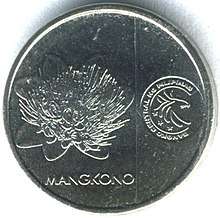 |
1 sentimo | 15 mm | 1.90 g | 1.54 mm | Nickel-plated steel | Plain | "Republika ng Pilipinas"; Three stars and the sun (stylized representation of the Philippine flag); Value; Year of minting; Mint mark | Xanthostemon verdugonianus (Mangkono); logo of the Bangko Sentral ng Pilipinas | March 26, 2018 |
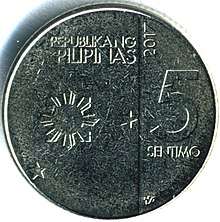 |
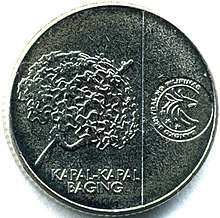 |
5 sentimo | 16 mm | 2.20 g | 1.60 mm | Nickel-plated steel | Reeded | "Republika ng Pilipinas"; Three stars and the sun (stylized representation of the Philippine flag); Value; Year of minting; Mint mark | Calotropis gigantea (Kapal-kapal Baging); logo of the Bangko Sentral ng Pilipinas | March 26, 2018 |
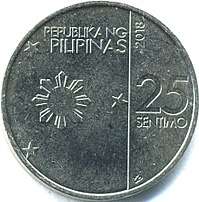 |
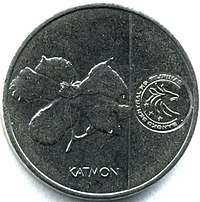 |
25 sentimo | 20 mm | 3.60 g | 1.65 mm | Nickel-plated steel | Plain | "Republika ng Pilipinas"; Three stars and the sun (stylized representation of the Philippine flag); Value; Year of minting; Mint mark | Dillenia philippinensis (Katmon); logo of the Bangko Sentral ng Pilipinas | March 26, 2018 |
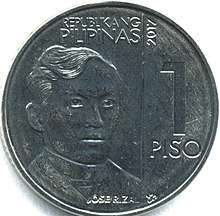 |
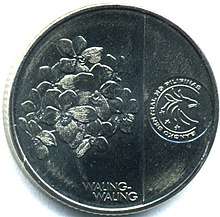 |
₱1 | 23 mm | 6.00 g | 2.05 mm | Nickel-plated steel | Segmented (Plain and Reeded edges) | "Republika ng Pilipinas"; Portrait of José Rizal; Value; Year of minting; Mint mark | Vanda sanderiana (Waling-waling); logo of the Bangko Sentral ng Pilipinas | March 26, 2018 |
 |
 |
₱5 | 25 mm | 7.40 g | 2.20 mm | Nickel-plated steel | Plain | "Republika ng Pilipinas"; Portrait of Andrés Bonifacio; Value; Microprint of "Republika ng Pilipinas"; Year of minting; Mint mark | Strongylodon macrobotrys (Tayabak); logo of the Bangko Sentral ng Pilipinas; Microprint of "Bangko Sentral ng Pilipinas" | November 30, 2017 |
_Philippines_Font.png) |
_Philippines_Back.png) |
₱5 (nonagonal shape) | 25 mm | 7.40 g | 2.20 mm | Nickel-plated steel | Plain | "Republika ng Pilipinas"; Portrait of Andrés Bonifacio; Value; Microprint of "Republika ng Pilipinas"; Year of minting; Mint mark | Strongylodon macrobotrys (Tayabak); logo of the Bangko Sentral ng Pilipinas; Microprint of "Bangko Sentral ng Pilipinas" | December 17, 2019 |
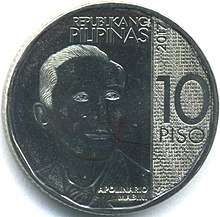 |
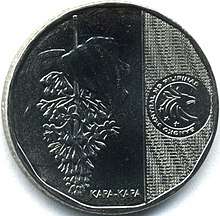 |
₱10 | 27 mm | 8.00 g | 2.05 mm | Nickel-plated steel | Reeded with edge inscription of "BANGKO SENTRAL NG PILIPINAS" in italics | "Republika ng Pilipinas"; Portrait of Apolinario Mabini; Value; Microprint of "Republika ng Pilipinas"; Year of minting; Mint mark | Medinilla magnifica (Kapa-kapa); logo of the Bangko Sentral ng Pilipinas; Microprint of "Bangko Sentral ng Pilipinas"; Microdots | March 26, 2018 |
 |
 |
₱20 | 30 mm | 11.50 g | 2.10 mm | Ring: bronze-plated steel | Plain edge with inscription of "BSP" at six angles | Ring: "Republika ng Pilipinas" | Scyphiphora (Nilad); logo of the Bangko Sentral ng Pilipinas; Malacañang Palace; Microprint of "Bangko Sentral ng Pilipinas" | December 17, 2019 |
| Center: nickel-plated steel | Center: Portrait of Manuel Quezon; Value; Microprint of "Republika ng Pilipinas"; Year of minting; Mint mark |
Current legal tender commemorative coins
On December 9, 2011, the Bangko Sentral ng Pilipinas (BSP) issued a commemorative one-peso coin in celebration of the 150th Birth Anniversary of José Rizal. The coins are in the same dimensions as the circulating one peso coins with Rizal's face from the front instead of in profile. The new coin also has the new logo of the central bank and is legal tender with the current series.[15]
On December 18, 2013, the Bangko Sentral ng Pilipinas issued a commemorative ten-peso coin in celebration of the 150th Birth Anniversary of Andres Bonifacio. The coins are in the same dimensions but the design changed. These also featured the new logo of the central bank and is also legal tender.
On December 22, 2014, the BSP issued three commemorative coins, a five-peso coin to commemorate the 70th Anniversary of the Leyte Gulf Landings,[16] a five-peso coin honoring Overseas Filipinos with the theme "Bagong Bayani"[17] and a ten-peso coin celebrating the 150th Anniversary of the birth of Apolinario Mabini.[18]
On January 14, 2015, the BSP issued two limited edition commemorative coins for the papal visit of Pope Francis, a 50-peso coin made of nickel-brass steel and a 500-peso coin made of Nordic gold with gold plating. A special logo with the theme "Mercy and Compassion" was minted on the reverse side of both coins, following the Pope's papal bull of indiction proclaimed later that year to mark the Extraordinary Jubilee of Mercy. The coins are minted under a licensing agreement with the Vatican. Both coins are legal tender.[19][20] Production and issuance of two additional silver and gold coins in 1000-peso and 10,000-peso denominations were called off due to limitations in the procurement process.[21]
On December 21, 2015, the BSP issued a commemorative 10-peso coin in honor of General Miguel Malvar, in time for the 150th year birth anniversary.[22]
On January 27, 2017, the BSP issued a commemorative one-peso coin in honor of the Philippines' Chairmanship of the Association of Southeast Asian Nations (ASEAN).[23]
In August and November 2017, the BSP issued commemorative one-peso coins and 10-peso coin both honoring the 100th anniversary of the birth of educator and historian Horacio de la Costa and the 150th anniversary of the birth of three officers of the Philippine Revolutionary Army, Generals Artemio Ricarte, Isidoro Torres and Antonio Luna.[24]
| Current legal tender commemorative coins | ||||||||
|---|---|---|---|---|---|---|---|---|
| Image | Value | Diameter | Weight | Composition | Edge | Obverse | Reverse | First Minted Year |
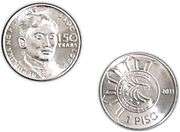 |
₱1 | 24.0 mm | 5.35 g | Nickel-plated steel | Reeded | "Republika ng Pilipinas", Profile of José Rizal, "150 Years", "1861-2011" | Logo of the Bangko Sentral ng Pilipinas with a facade of the sun, value, year of minting | December 9, 2011 |
| ₱1 | 24.0 mm | 5.35 g | Nickel-plated steel | Reeded | "Republika ng Pilipinas", Profile of Artemio Ricarte, "Heneral Artemio Ricarte", "150 Years" | Logo of the Bangko Sentral ng Pilipinas, value, year of minting | August 24, 2017 | |
| ₱1 | 24.0 mm | 5.35 g | Nickel-plated steel | Reeded | "Republika ng Pilipinas", Profile of Isidro Torres, "Heneral Isidro Torres", "150 Years" | Logo of the Bangko Sentral ng Pilipinas, value, year of minting | ||
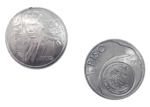 |
₱1 | 24.0 mm | 5.35 g | Nickel-plated steel | Reeded | "Republika ng Pilipinas", Profile of Horacio De la Costa, "Rev. Horacio De la Costa", "100 Years" | Logo of the Bangko Sentral ng Pilipinas, value, year of minting | |
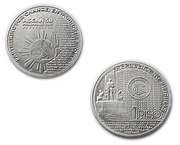 |
₱1 | 24.0 mm | 5.35 g | Nickel-plated steel | Reeded | "Partnering for Change, Engaging the World"; "ASEAN 50"; "Philippines 2017"; the sun from the flag of the Philippines with dove and emblem of the Association of Southeast Asian Nations (ASEAN); names of the members of the Association of Southeast Asian Nations (ASEAN) in microtext | Monument of José Rizal at Rizal Park; "Republika ng Pilipinas"; "1 Piso"; logo of the Bangko Sentral ng Pilipinas; names of the members of the Association of Southeast Asian Nations (ASEAN); microtext | January 20, 2017 |
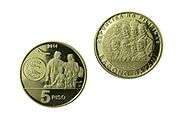 |
₱5 | 27.0 mm | 7.7 g | Nickel-brass | Plain | "Republika ng Pilipinas", profile of Filipinos of various professions, "Bagong Bayani" | Date of issue, passenger jet, logo of the Bangko Sentral ng Pilipinas, a Filipino family, denomination | March 3, 2014 |
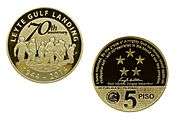 |
₱5 | 27.0 mm | 7.7 g | Nickel-brass | Plain | "Leyte Gulf Landing", scene of the landing, "70th Anniversary", "1944-2014" | "I have returned. By the grace of Almighty God our forces stand again on Philippine soil - soil consecrated from the blood of our two peoples.", five stars denoting the rank of field marshal, date and signature of Douglas MacArthur, logo of the Bangko Sentral ng Pilipinas, denomination | September 30, 2014 |
 |
₱10 | 26.5 mm | 8.7 g | Bi-metallic (Copper nickel outer ring with an aluminum bronze center plug) | Segmented | "Republika ng Pilipinas", Profile of Andres Bonifacio | Monument of Andres Bonifacio, "Dangal at Kabayanihan", signature of Andres Bonifacio, logo of the Bangko Sentral ng Pilipinas, "150 Years", "1863-2013" | November 22, 2013 |
 |
₱10 | 26.5 mm | 8.7 g | Bi-metallic (Copper nickel outer ring with an aluminum bronze center plug) | Segmented | "Republika ng Pilipinas", Profile of Apolinario Mabini, quill pen | "Talino at Paninindigan" Monument to Apolinario Mabini, signature of Apolinario Mabini, logo of the Bangko Sentral ng Pilipinas, "150 Taon", "1864-2014" | August 20, 2014 |
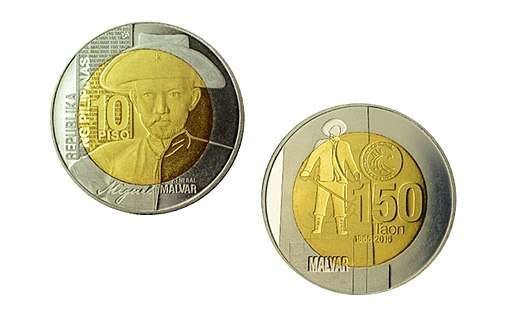 |
₱10 | 26.5 mm | 8.7 g | Bi-metallic (Copper nickel outer ring with an aluminum bronze center plug) | Segmented | "Republika ng Pilipinas", portrait and signature of Miguel Malvar, denomination | Logo of the Bangko Sentral ng Pilipinas, figure of Miguel Malvar, "150 Taon", "1865-2015" | September 18, 2015 |
| ₱10 | 26.5 mm | 8.7 g | Bi-metallic (Copper nickel outer ring with an aluminum bronze center plug) | Segmented | "Republika ng Pilipinas", portrait and signature of Antonio Luna, denomination | Logo of the Bangko Sentral ng Pilipinas, figure of Antonio Luna, "DANGAL, TAPANG, DIGNIDAD" text, "150 Taon", "1866-2016" | November 24, 2017 | |
| ₱50 | 27 mm | 7.7 g | Nickel-brass | Plain | "Republika ng Pilipinas", portrait and signature of Pope Francis, denomination, year of minting, BSP mint mark | Logo of the Bangko Sentral ng Pilipinas, "Papal Visit/Philippines", date of visit "January 15–19, 2015", logo of the Papal Visit 2015, mini letters "Mercy and Compassion" | January 14, 2015 | |
| ₱500 | 34 mm | 15 g | Nordic gold | Reeded | "Republika ng Pilipinas", portrait and signature of Pope Francis, denomination, year of minting, BSP mint mark | Logo of the Bangko Sentral ng Pilipinas, "Papal Visit/Philippines, date of visit "January 15–19, 2015", logo of the Papal Visit 2015, mini letters "Mercy and Compassion" | ||
Notes
- All of these coins bore a single reverse design, the federal shield surmounted by an American eagle clutching an olive branch in its right claw and a bundle of arrows in its left. Around this appeared the legend UNITED STATES OF AMERICA and the date of coinage. The obverse of the minor coins (the half centavo and one centavo, both coined in bronze, and the copper-nickel five centavos) featured the semi-nude figure of an adolescent native, seated at an anvil and holding a hammer in his right hand. In the distance is seen the smoking volcano of Mt. Mayon, located on the main island of Luzon. The statement of value appears above him in English, while the name of the archipelago is written below in Spanish as FILIPINAS. This employment of Spanish is curious, given the islands’ recent history, yet it remained for some years afterward the principal language of the educated class. For the silver coins (ten, twenty and fifty centavos, plus the one-peso piece), the standing figure of an adolescent female was utilized. She is clad in a long, flowing gown and holds in her right hand a hammer, resting atop an anvil, as seen on the minor coins. Behind her is again Mt. Mayon, an almost perfectly conical volcanic mountain northeast of the capital city of Manila. These designs are credited to Filipino sculptor Melecio Figueroa, who lived just long enough to see his coins enter circulation.
- The transition from protectorate to commonwealth, which occurred November 15, 1935, was commemorated on a set of three coins dated 1936-M. The fifty-centavo piece shows facing portraits of outgoing Governor-General Frank Murphy and incoming President Manuel Quezon. They are portrayed again on one of the peso coins, this time in profile, their busts overlapping. This same configuration is used for the other one-peso commemorative, but on its obverse the subjects are President Quezon and President of the United States Franklin D. Roosevelt. This is a very rare instance of a living U. S. president appearing on a United States coin. The common reverse for all three coins depicted the arms of the Commonwealth of the Philippines. Featuring elements symbolic of Spain, The USA and the islands themselves, it was adopted as the common reverse for all regular-issue coins beginning in 1937.
- All of these coins bore a single reverse design, the federal shield surmounted by an American eagle clutching an olive branch in its right claw and a bundle of arrows in its left. Around this appeared the legend UNITED STATES OF AMERICA and the date of coinage. The obverse of the minor coins (the half centavo and one centavo, both coined in bronze, and the copper-nickel five centavos) featured the semi-nude figure of an adolescent native, seated at an anvil and holding a hammer in his right hand. In the distance is seen the smoking volcano of Mt. Mayon, located on the main island of Luzon. The statement of value appears above him in English, while the name of the archipelago is written below in Spanish as FILIPINAS. This employment of Spanish is curious, given the islands’ recent history, yet it remained for some years afterward the principal language of the educated class. For the silver coins (ten, twenty and fifty centavos, plus the one-peso piece), the standing figure of an adolescent female was utilized. She is clad in a long, flowing gown and holds in her right hand a hammer, resting atop an anvil, as seen on the minor coins. Behind her is again Mt. Mayon, an almost perfectly conical volcanic mountain northeast of the capital city of Manila. These designs are credited to Filipino sculptor Melecio Figueroa, who lived just long enough to see his coins enter circulation.
References
- "Scrapping lower-valued coins unfair to consumers".
- "LOOK: BSP unveils updated 5-peso coins". CNN Philippines. 29 November 2017.
- BSP Releases New Generation Currency Coins
- Bangko Sentral to create P20 coin, Rappler, July 19, 2019
- All mintage numbers are from A Guide Book of United States Coins: The Official Red Book, R.S. Yeoman (November 1946), United States: Whitman Publishing LLC, ISBN 978-0794845711
- All year dates and mint mark denominations are from A Guide Book of United States Coins: The Official Red Book, R.S. Yeoman (November 1946), United States: Whitman Publishing LLC, ISBN 978-0794845711
- "Philippines Under U.S. Sovereignty". Numismatic Guaranty Corporation. Retrieved February 20, 2019.
- http://www.bsp.gov.ph/bspnotes/hist_dem_coin_eng.asp
- http://www.bsp.gov.ph/bspnotes/hist_dem_coin_pil.asp
- http://www.bsp.gov.ph/bspnotes/hist_dem_coin_abl.asp
- http://www.bsp.gov.ph/bspnotes/hist_dem_coin_faf.asp
- Cabuenas, Jon Viktor D. (March 26, 2018). "BSP releases New Generation Currency Coins". GMA News.
- https://www.rappler.com/business/235646-bangko-sentral-pilipinas-to-create-philippine-peso-20-coin
- Proposal for a P20 coin needs 'in-depth' deliberation, study: BSP ABS-CBN (news.abs-cbn.com). July 19, 2019. Retrieved on 2019-08-04.
- "BSP to Issue One-Piso Commemorative Rizal Coin in December". Bangko Sentral ng Pilipinas. Retrieved 2011-12-30.
- Philippines 5 piso 2014 - Leyte Gulf landing World Coin News (worldcoinnews.blogspot.com). December 26, 2014. Retrieved on 2014-12-26.
- Philippines 5 piso 2014 - Bagong Bayani World Coin News (worldcoinnews.blogspot.com). December 26, 2014. Retrieved on 2014-12-26.
- Philippines 10 piso 2014 - Apolinario Mabini World Coin News (worldcoinnews.blogspot.com). December 26, 2014. Retrieved on 2014-12-26.
- Bangko Sentral ng Pilipinas (January 14, 2015). "BSP Issues Limited Edition Commemorative Coins of the Papal Visit". bsp.gov.ph. Retrieved February 20, 2019.
- "BSP to issue commemorative Pope Francis coins". Rappler.com. January 14, 2015. Retrieved February 20, 2019.
- Bangko Sentral ng Pilipinas (February 27, 2018). "Cancellation of Production of Silver and Gold Pope Francis Commemorative Coins". bsp.gov.ph. Retrieved February 20, 2019.
- "BSP issues limited edition P10-Miguel Malvar coin". Rappler. 21 December 2015. Retrieved 22 December 2015.
- Philippines 1 piso 2017 - Chairmanship of ASEAN World Coin News (worldcoinnews.blogspot.com). January 27, 2017. Retrieved on 2017-01-27.
- "BSP to Issue Limited Edition Commemorative Circulation Coins of Reverend Horacio dela Costa, General Artemio Ricarte and General Isidro Torres". Bangko Sentral ng Pilipinas. August 24, 2017. Retrieved February 20, 2018.
